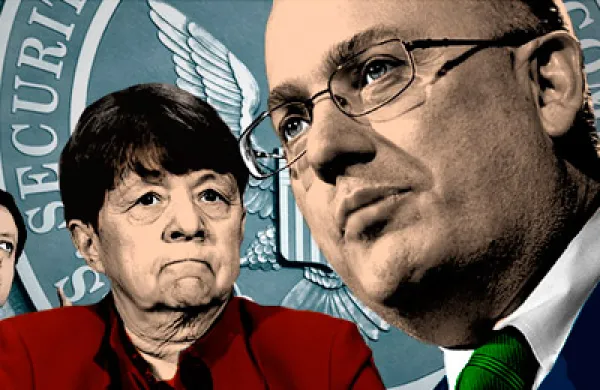All securities could go digital over the next five to 10 years — creating opportunities and challenges.
That’s one finding from a new report from Arca Asset Management. Although Arca, a firm that specializes in investing in digital assets, clearly has an interest in a world of virtual securities, its report was based on a July 2021 survey that compiled responses from over 100 financial service professionals, including those who work at buy-side firms, banks, brokerages, exchanges, and market infrastructure and technology firms. Arca’s survey was designed to gauge sentiment surrounding the adoption of digital asset securities.
“Digital asset [securities] are a wrapper, like a stock, but just a more efficient one,” Rayne Steinberg, Arca’s chief executive officer and co-founder, told Institutional Investor. “You could represent any stock in the world [in] a digital asset.” Whether or not a digital asset is classified as a security depends on the asset’s jurisdiction. In the U.S., the Securities and Exchange Commission makes that decision.
The report’s authors wrote that the digital asset securities sector is often overshadowed by others in the market, such as video gaming and non-fungible tokens, or NFTs — a fact that Steinberg attributes to the general “unknown-ness” of the space. “We have this gray area where there are a lot of unregistered digital assets, and this lack of clarity is one of the biggest impediments to institutional adoption,” Steinberg said. “They can’t own something that is an unregistered securities offering. That could be a violation for them.”
Despite the relative lack of attention surrounding digital asset securities, the authors believe every security will eventually be digitized, and survey respondents agreed: Seventy-seven percent of respondents said they believe most securities will be digitized and settled on a blockchain sometime in the next decade.
“Right now, you’re seeing this paradigm shift at institutions,” Steinberg said. “Maybe even just a year ago, even mentioning digital assets or crypto could be a reputational or employment risk. Now, it’s starting to be seen as the future of the entire industry. The speed of that conversion — I’ve never seen anything like it.”
A digital asset is issued using distributed ledger technology (DLT) or blockchain. Like NFTs, a one-of-a-kind token or piece of art work, a digital asset security is a twin of any traditional investment.
Arca Labs president Jerald David said this “paradigm shift” to digitized securities is a theme that will gain momentum in 2022. For example, as smaller firms continue to develop technologies and services, larger, traditional institutions (which David calls “incumbents”) will need to move into digital asset securities to maintain a competitive edge, David said. “Smaller institutions that are more nimble [have] been creating entities and products and services that have been getting pretty close to what the incumbents currently have,” David told II. “At some point, the incumbents are going to use their [resources] to move into the digital asset security space to fend off competitors.”
David said the benefits provided by digital asset securities are too great for investors to overlook. For institutional investors, the key benefits of block-chain-based settlement for digital asset securities include real-time settlement (86 percent of respondents said this was among the top benefits), transparency (71 percent of respondents), and fractional ownership (61 percent of respondents).
Survey respondents also indicated that they would like to see a range of assets represented as digital assets. These included investment funds, real estate, equities, venture capital, private equity, fixed income, art and collectibles, and commodities.
Products like Prometheum’s Ember Alternative Trading System (ATS) are facilitating that transition for both retail and institutional investors. Prometheum is a market infrastructure company that specializes in blockchain. Earlier this month, Prometheum gained SEC approval to operate its ATS, meaning investors will be able to buy, sell, and manage digital securities through the approved trading system.
For Aaron Kaplan, Prometheum’s founder and co-CEO, the approval marks the first step in taking digital asset securities mainstream. But to integrate tokenized securities into the normal investment practices of large institutions, more digital asset products and infrastructure need to gain regulatory approval. “The writing’s on the wall,” Kaplan told II. “2022 will be a seminal year in terms of integration from the institutional side.”
Greg King, the founder and CEO of Osprey Funds, a digital asset investment fund, doesn’t agree that all securities will be digitized in the next decade. He does believe, however, that a subset of securities will be tokenized in that time. He said the widespread adoption of digital assets in the next decade will largely depend on the continued development of infrastructure and the regulatory approval of that infrastructure. One scenario, he said, might involve regulators allowing a national stock exchange to trade digitized securities. “[That] would be step one,” King told II.
Arca’s report points out that the rise of these securities won’t necessarily be a smooth ride for participants. The same regulation of securities transactions that will bring digital assets into the mainstream also makes innovation in the sector costly and time-consuming, the authors wrote.
Steinberg added that large, traditional institutions aren’t accustomed to the rapid scale and speed of blockchain adoption. In the case of blockchain, the “disruption” is happening at such a rapid pace that regulators can’t keep up and institutions don’t have the clarity they need to move into the space.
The CEO of Arca compared the development of blockchain to the early days of exchange-traded funds. “I founded an ETF company in the early 2000s. ETFs came out of the [1987] crash and developed in the early ’90s with the cooperation of regulators,” Steinberg said. “Even in 2000, we were [still] getting institutional adoption. That’s a very long time period, [but that’s] the scale and speed institutions usually deal with the adoption of something like this.”
Osprey Funds’ King expects ATPs like Prometheum’s to continue to grow in popularity in the coming years, especially since they’re currently the only way to access digital asset securities. “Determined investors go where they need to go to trade what they want to trade,” he said. “The question is, how compelling is it for institutions to use these venues? I think they’ll get more comfortable over time.”






